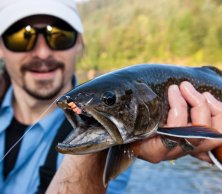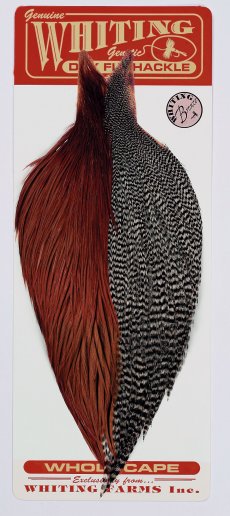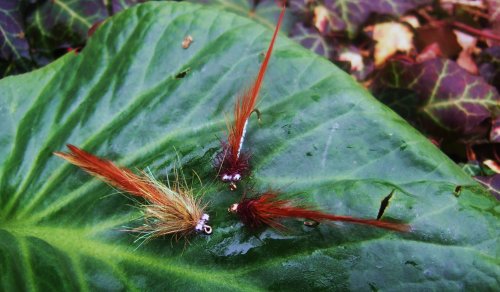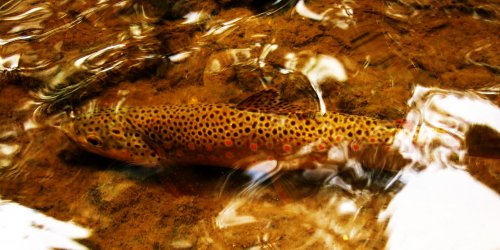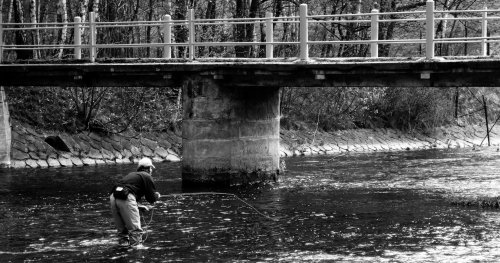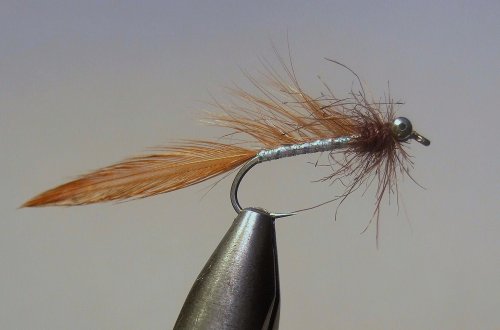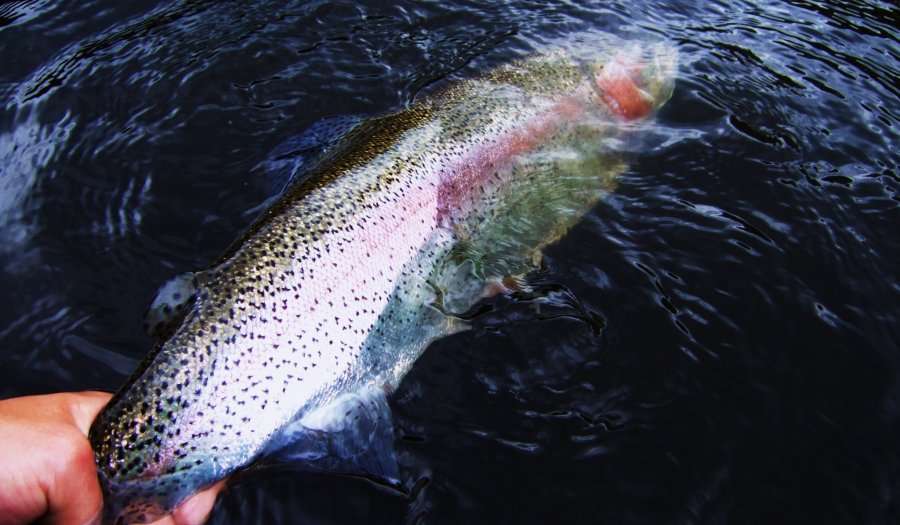Article about tying great small river streamer.
Introduction:
The topic of today’s article is one of my favorite small and simple river streamer patterns, which because of its light construction can also be used as a larger wet fly – meaning in how it is fished. I used this pattern very often and with much joy some years ago, and still reach for it mainly as a trout, chub, and perch fly. I write “some years ago”, since for most of my patterns I see a certain development in my fishing with them. I always become enamored with a particular pattern and fish primarily with it. As time goes by, I find a new pattern and leave the old one behind, though just for a while. I always return to tying and fishing with previous patterns and again gain new experiences. I think this is a natural process. Humans tend to continue to find and develop new things, but should never forget what previously brought them success and great moments… Stay faithful, but with an eye to new advances.
Equipment and fishing technique:
This “Cheeky” pattern is very fine and light, so it does not need to be over-dimensioned. A standard river rod AFTMA 3-6 and 2.55 – 2.75 meters long is fine, with DT or WF floating line. The use of floating line with a sinking or intermediate tip is also a very good alternative for fishing this fly. I use a leader of 0.12 – 0.18 mm. For a fly of this size I don’t expect to catch pike, so I chose the size of the leader based on the water clarity plus size and type of fish. For lake fishing I naturally adapt my equipment to the situation (wind, depth where the fish are, size of fish, etc.). I mainly use this fly on rivers, however, where its construction is more suited.
How to fish:
As I wrote, the number one place to use this fly is on running waters. Its construction is therefore developed for river currents and for places where fish don’t have long to inspect the “liveliness” of our fly. In these situations, the fish has to quickly choose – grab the bait, or go hungry. Decisions are made in a matter of seconds!
To fish the “Cheeky”, I use two methods. The first is the classic wet/streamer method, where I cast the fly across the current toward the opposite bank, enliven its movement with slight pulls, and using small tugs on the line lead the fly from the bank to the middle of the river. I don’t use more than two flies, and the Cheeky Devil is always on the tip. For the dropper I rather use a smaller natural wet fly with distinctive elements (a small gold head, or distinctive tip). The method is very successful mainly for chub, which like to stay near the shore and hunt insects from the bank and overhanging grass as well as small minnows that take cover there. I have also had days when I’ve been very successful for bream, in which the Cheeky Devil manages to bring out the inner predator. The second method of fishing is most effective in smaller rocky trout stretches with pools and calm spots among the currents, where trout lie in wait for small aquatic prey. In this case I cast against the current on a short leader (1.5 – 2 m) downstream, with quick pulls retrieving out of a pool or weaker ripples. This style is reminiscent of a confused escaping small fish that mistakenly heads to the territory of a hunting trout.
Why not on lakes? The answer is simple – the fly construction is rather static due to the use of the rooster feather. Such a fly will look dull and lifeless on stillwaters and not attract the attention of fish as well as we need in lakes. That doesn’t mean of course, that it will be completely useless.
Tying materials used:
The materials used for the Cheeky Devil Matuka are very few. That’s the strength of this fly - a light and austere feeling – or as they say “simplicity is beauty”. It’s not necessary to go overboard and experiment with adding material. I have tried this myself – giving the fly a fine marabou tail, enhancing the body, making the thorax more distinct – but I always had to come back to the basic pattern because that’s what the fish reacted to best.
Hook:
I’ve come to appreciate stronger lake hooks, if possible with a longer shank though that’s not necessary. I also tie the “Cheeky” on nymph lake hooks with classic shanks. The fly is shorter and smaller, looking a bit more like a wet fly, but just as effective. The advantage of the lake nymph hook is its strength and deeper bend, which makes it sit in the fish’s mouth better.
Thread:
Don’t use too strong a thread. We must always keep in mind that we want this fly to be as slim as possible, which stronger thread doesn’t help. The best option is firm but thin double-filament thread. The color is important, since the foundation of the body is made from transparent shiny tinsel that the thread shows through. So whatever thread you use will end up affecting the color of the fly. I like to use white and grey colors, which keep the body looking naturally subdued and colored like a fish’s belly.
Eyes:
Again I prefer bead chain eyes. Trout in particular react very positively to these eyes, and take flies with this look easily and confidently. The same for chub, perch, and asp. The fly itself moves very naturally and lifelike. Bead chain eyes on this fly serve as the only weight, and make it slightly fall head-first.
Tinsel:
Forms a gleaming svelte body. I use two types of tinsel for the Cheeky Devil – the first is the foundation. This is transparent with a slight pink-green hint. I use a larger diameter to reduce windings. The second tinsel is holographic, whose function is to increase the fly’s attractiveness mainly in sunny weather, when the sun’s rays penetrate the water surface.
Wing/back/tail:
Made from 2 quality honey dun cock fibers.
Monofilament:
Used as a stiffening and at the same time ribbing material. I use clear or brown monofilament 0.12 mm in diameter. This can be substituted by gold, brass or black wire, but wire has the tendency to break so I find that mono is better suited for this purpose.
“Legs”
Not necessary, but when I do tie them I use the same rooster feather as for the back or more finely moving hen. I use this to form a thin ring-like collar of “legs”.
Neck/thorax:
This should be the most massive part of the fly, though not too much. I use rough seal dark brown dubbing or a combination of rough dubbing (seal or hare) with shiny synthetic dubbing such as angel hair, gleamy dubbing, etc.
Lacquer:
A hardening material, which I use between every tying step. In this case we can use epoxy glue to firm up and mainly as a visible element of the tinseled body. After tying in the tinsel, I lacquer the whole body, which hardens it but also enriches it with air bubbles on the surface, giving it a much more attractive look. This takes a long time, of course, as you must wait for the epoxy to dry, for which a Rota-Dry system is useful, so I often end up skipping this step.
Tying steps:
Step 1:
Insert a barbless hook in the vice and fix the tying thread at the hook eye. Put a small drop of superglue on the thread, and lay two small bead chain eyes on it. Tie the eyes on with figure-eight coils where the hook eye ends, and lacquer the loops of thread.
Step 2:
Spread a thin layer of lacquer over the hook shank and wind the thread towards the hook bend in regular tight coils. These regular and tight coils create a firm foundation for the body, preventing the fly body from slipping off the hook. He who lacquers, knows. He who does not lacquer, will know soon enough J
Step 3:
Tie in the monofilament for ribbing. For all ribbing materials (monofilament, wire, tinsel, etc.), I tie in at the bend, work up to the hook eye and then back down. In this way I achieve a balanced body without a more massive section near the bend, which is the place where usually just a short section of ribbing and body materials are tied in.
Step 4:
In the same way, tie in the holographic tinsel ribbing.
Step 5:
Continue attaching the tinsel and move the thread up toward the eye of the fly.
Step 6:
With precise and tight coils, create the body with transparent tinsel, tie down the tinsel with tying thread, and trim the excess.
Step 7:
Rib the body with holographic tinsel, and tie off with thread just like the body tinsel.
Step 8:
Tie in two opposite cock feathers. The length extending off the back should be about the same as the hook shank length. The feather should be tied exactly in line with the body – be careful that it doesn’t shift or become offset to one side or the other. This would negatively affect the fly’s movement, becoming distorted in the current and with various unwanted rotating while retrieving.
Step 9:
Using the “matuka” style developed in New Zealand for tying streamer wings for their lake trout, we tie in the “Cheeky” wing. Take the feather and hold it against the body of the fly. At the end of the body, where we want to start tying down the feather, separate the fibers by pulling toward the front of the quill opposite the direction of growth. This creates a gap allowing you to start tying the wing to the body. In the same way, separating then ribbing, work your way up the fly, then tie off the monofilament ribbing with thread and trimming. In case you accidentally trap any of the upper fibers under the ribbing, use a needle to gently pull them out. In this fly I leave the lower fibers intact along the length of the body. The back of the fly thus has a thicker profile, and the sparse amounts of these lower fibers don’t get in the way of anything. For denser feathers in most flies, the lower fibers are usually stripped off before tying down.
Step 10:
Dub a hackle of dubbed seal dubbing in loops. Finish off the fly by tying off and lacquering the knot.
A word in conclusion:
The Cheeky Devil Matuka is a fly that is easily and quickly tied. I developed it at the start of my fly fishing era, and it is one of those flies that have brought me many beautiful moments at the water, and which made me a fly-fishing addict for life. It is a small fly with a big personality. I hope that you polite and thoughtful fishers will find these qualities in it as well, and be rewarded as it forms in your vice J
Catch & Release Forever!







